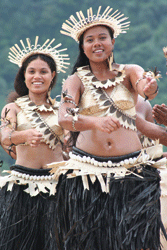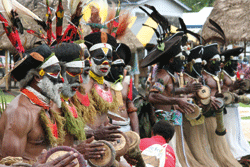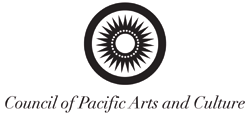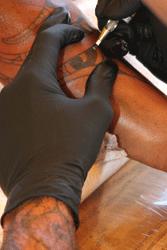
Celebrating Culture: IP & Arts Festivals

Performers at the Festival of Pacific Arts.
These events are celebrations of the
richness and diversity of culture and
creativity. (Photo: Secretariat of the Pacific
Community)
By Brigitte Vézina, Legal Officer, Traditional Creativity, Cultural Expressions and Cultural Heritage Section, WIPO
Arts festivals are a cultural highlight in many towns, cities and countries worldwide. Celebrations of the richness and diversity of culture and creativity, they often encompass a variety of contemporary and traditional art forms — dance, music, theatre, arts and crafts. Culturally, they offer a unique snapshot of a community’s identity, both providing an opportunity to revitalize and preserve cultural practices, and often serving as a creative laboratory for contemporary performers. Socially, they are a means of strengthening intercultural dialogue, promoting deeper understanding through shared experience; and economically, they can generate sizeable, long-term financial benefits and significant business and employment opportunities. For example, the Edinburgh Festival, the world’s largest arts festival, injects annually some US$269 million into Scotland’s economy. Effective intellectual property (IP) management is an important aspect of the planning process that organizers need to address to safeguard and promote the event’s interests and those of festival participants.
WIPO works with organizers of events, such as the Festival of Pacific Arts to be held in the Solomon Islands in July 2012, to help them develop appropriate IP management strategies and tools to deal with the IP issues that can arise before, during and after such events. This article identifies the main IP challenges organizers face and outlines some practical ways of dealing with them.
No IP strategy – a risky business
The unique cultural performances and displays of participating artists, performers and artisans draw public interest and build the reputation of a cultural event. Without appropriate safeguards, these works are vulnerable to unauthorized exploitation by outsiders. With digital cameras at hand, for example, audiences can easily capture high-quality recordings of these performances. Many performers, unaware of their IP rights, often learn that unauthorized copies of their works — many of which contain culturally-sensitive material — have been used by third parties without their consent and in an inappropriate manner.
Neglecting to implement a comprehensive IP strategy also exposes festival audiences to the risk of being duped into purchasing fake arts and crafts. Such opportunistic business practices damage the continuing interests, reputation and popularity of the event itself.

WIPO is working with organizers of the Festival of
Pacific Arts to help them develop appropriate IP
management strategies and tools to deal with the IP
issues that can arise before, during and after such
events. (Photo: Secretariat of the Pacific Community)
Hands-on IP management
Used strategically, IP can help generate significant revenue, for example from the sale of broadcasting rights, and the conclusion of sponsorship and merchandizing deals. A positive, forward-looking IP strategy enables organizers to exercise greater control over a festival’s IP and cultural interests. A mix of IP tools, particularly copyright and trademark rights — used in association with contracts, protocols, guidelines, notices, accreditation and access conditions — can provide a comprehensive framework for protecting IP and guarding against the misuse of traditional knowledge (TK) and traditional cultural expressions (TCEs).
Key IP concerns
Copyright
The unauthorized recording and distribution of cultural expressions such as sound recordings, film or video clips and photographs are major concerns. Generally speaking, copyright law offers a degree of protection for creators of “original” artistic works. However, festival organizers may need to take complementary steps to protect the cultural interests of participants whose works do not qualify for copyright protection because of their traditional character. For example, traditional crafts and designs are unlikely to qualify for IP protection in many jurisdictions. Moreover, while copyright confers the right to authorize or prevent the adaption of a protected work, it does not stop other creators from being inspired by it. Drawing a line between copying and inspiration is a tough challenge.
Measures to control unauthorized recording and distribution of cultural expressions include the use of:
- Cautionary notices, such as “no filming, photography or recording devices allowed”. Usually placed at points of sale, onsite or published on the festival’s tickets, website and official program, these notices can help protect the IP, TK and TCE interests of performers as well as restrict unauthorized recordings. Oral warnings may also be given prior to a performance;
- Guidelines and protocols outlining the terms of use of official festival recordings and advising members of the media and the general public about the need to respect the TK and TCEs of festival participants;
- A media accreditation system to ensure that journalists provide details of the proposed use of festival recordings;
- Measures to monitor use of media broadcasts and to clamp down on infringing content. Broadcasters pay large amounts for exclusive coverage of an event. If organizers are to fully leverage the sale of broadcast rights they need to guarantee this exclusivity;
- Protocols can be used to ensure proper attribution to custodians of TK and TCEs, or to promote respect for the sacred character of particular performances.
Examples of unauthorized use of performance recordings include:
- use of a photograph of a performance to illustrate a compilation of so-called “indigenous” music completely unrelated to the performers or their community and for sale on the Internet;
- the sale in tourist retail outlets of postcards reproducing images of a sacred dance show;
- a local art gallery selling miniature reproductions of a background set painting;
- use of a video clip of a performance for a television advertisement and on an Internet video sharing site to promote tourism;
- a CD of contemporary and original songs inspired by the traditional music of a community, recorded illegally during a performance, on sale at other festivals and in record stores;
- replicas of intricate, traditionally-designed dance costumes made using ancestral weaving methods for sale in a fashion designer’s boutique;
- the elaborate face painting of festival performers used by contemporary dancers out of context and in an inappropriate way.

Trademarks
Abusive use of a festival’s artwork or logo and the sale of fake arts and crafts are a serious threat to its reputation and financial viability. These problems can be tackled, in large part, by registering a trademark for the festival. Trademark protection generally confers the exclusive right to prevent others from marketing identical or similar products under the same or a confusingly similar mark. Trademarks associated with arts festivals can be registered in a variety of classes of goods, including festivals, recordings, publications and merchandise (such as visual arts, crafts, books and other products) in each country in which the festival is held. Trademark registration opens the way to developing an effective marketing strategy and to concluding potentially profitable sponsorship and merchandizing deals.
As a registered trademark holder, organizers are better placed to promote the sale of authentic products, thus generating revenue for artists and the festival alike, both onsite and in the online market. They are also better equipped to defend themselves against cybersquatting (the abusive registration of their mark as a domain name), thereby safeguarding their web presence which is a key marketing tool.
Measures to safeguard the festival’s branding:
- registering a trademark;
- securing a domain name;
- developing a merchandizing program that defines the festival’s product portfolio;
- establishing a sponsorship program defining levels of sponsorship and associated rights;
- establishing official retail outlets onsite and online; and
- monitoring the online market for infringing products.

In ancient Polynesian society, tribal
tattoos were a means of expressing
identity and personality. Growing
interest and pride in their cultural
heritage has fuelled a renaissance in
the art of tattooing among Polynesians.
(Photo: Secretariat of the
Pacific Community)
Making it happen
To ensure that an event’s IP policy and its associated guidelines, protocols and notices are effectively enforced, organizers are best advised to establish a written contract with all parties concerned (including members of the public, the media (photographers and print, TV and radio journalists) and performers and exhibitors. Organizers typically do this through licenses, performer’s release forms and accreditation agreements, the terms of which are made widely available. Such arrangements can cover matters relating to:
- IP rights, including trademarks, copyright and related rights;
- TK-related interests (recognition, protection and safeguarding of the interests of TK and TCE holders); and
- compensation – monetary or in kind (for example, sharing benefits derived from exploitation of recordings with the community or for charity; use of a commercial photograph on a poster to promote the festival; donation of copies of recordings to the festival archive for cultural maintenance purposes, etc.).
Organizing an arts festival is a complex undertaking encompassing many marketing and managerial elements. An effective strategy designed to uphold the IP and cultural interests of all parties is central to an event’s long-term success. While conventional IP tools offer some degree of protection, other complementary measures, such as contracts, protocols, guidelines, notices, accreditation systems and access conditions are also required, particularly where displays of TK and TCEs are concerned. A strategy that aims to protect the IP and cultural interests of all parties helps foster cultural respect, and generates economic opportunities for continued celebration of the uniqueness and diversity of cultures around the world.
| Festival of Pacific Arts |
|---|
|
WIPO supports the Secretariat of the Pacific Community, the Council of Pacific Arts and the Solomon Islands in developing an effective IP strategy for the Festival of Pacific Arts. Held every four years in one of the 27 countries that make up the region, the festival seeks to combat the erosion of cultural practices and is a celebration of the rich diversity of Pacific arts, culture and knowledge. WIPO’s broad-spectrum support includes advice on the use and application of conventional IP law, as well as other practical measures to safeguard TK and TCE interests in line with the Pacific Regional Framework for the Protection of Traditional Knowledge and Expressions of Culture (2002) and the work of the WIPO Intergovernmental Committee on Intellectual Property and Genetic Resources, Traditional Knowledge and Folklore (IGC). |
The WIPO Magazine is intended to help broaden public understanding of intellectual property and of WIPO’s work, and is not an official document of WIPO. The designations employed and the presentation of material throughout this publication do not imply the expression of any opinion whatsoever on the part of WIPO concerning the legal status of any country, territory or area or of its authorities, or concerning the delimitation of its frontiers or boundaries. This publication is not intended to reflect the views of the Member States or the WIPO Secretariat. The mention of specific companies or products of manufacturers does not imply that they are endorsed or recommended by WIPO in preference to others of a similar nature that are not mentioned.